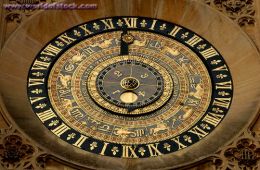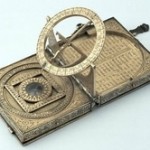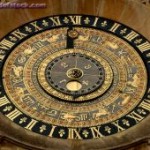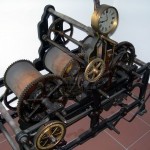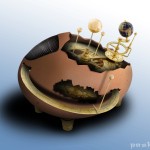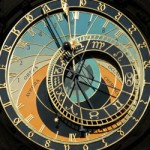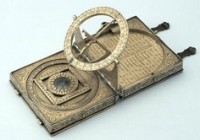The Clock Through History
Ideas about time keeping go back thousands of years, starting from an ancient orrey; the Antikythera mechanism










In a world obsessed with time, we just don’t seem to have enough clocks
The history of the modern clock was something born out of necessity. When Europeans were sailing the vast ocean distances, they had no trouble finding latitude with an astrolabe, but finding longitude was something entirely different. In navigating by longitude, the navigator has to deal with rising, setting and moving stars, which requires some form of time tracking. On land, this is not a problem, as vast temple complexes such as at Teotihuacan, Egypt and India were constructed for the purpose oftracking the movements of the sun, moon, planets and stars. These temples were all oriented to the sky as most ancient civilizations were obsessive sky watchers. Some , such as in India, were highly accurate, measuring the true rotation of the inconstant Earth. However, such measuring devices were unpractical on the high seas, not only for their shear size, but also the instability and small size of a ship’s deck tossed on the waves. Not only was that, tracking the stars for either latitude or longitude impossible on cloudy and stormy days. Nor was a sundial of any use in a situation where actual distance traveled was needed as well as a steady, constantly direction oriented environment.
Our current clock came to have 24 hours as the influence of the 12 zodiacal signs was incorporated into the design of tracking time. The day and the night were divided into 12 segments each. This is thought to originate from the light and dark sides of each zodiac sign. As the original western calendar had 360 days, this was turned into degrees. This was later incorporated into the circle and eventually the division of time with some variations, i.e., 60 minutes times 60 seconds for 3600 seconds. The coupling of the clock with astronomy was important as will be described.
The clock has a long history that varies with temple complexes, the water clock, the hourglass, markedcandles that were used individually or in combination, and ultimately the mechanical clock. In fact, an ancient mechanical time piece recently surfaced from the depths of the Mediterranean Sea; the Antikythera mechanism, which turned out to be an accurate orrey, but a time keeper nontheless. The theory around the Antikythera mechanism is that it was set to the planetary positions of the day and then set to run, accurately tracking the movement of the visible planets. But that knowledge was lost, likely in the dark ages after the 6thcentury.
For the purposes of civilization, agriculture, timed jobs and prayer, an accurate time piece was required. Massive temples were used for much of history for many great and powerful civilizations. These were so accurate it allowed the Mayans to develop the world’s most accurate calendar. For sea travel hugging shorelines, the lack of a timepiece was not a problem, especially considering the capriciousness of the sea and weather. For deep sea travel, it was a serious problem. Therefore, a major stimulus to improving the accuracy and reliability of clocks was the importance of precise time-keeping for navigation. The position of a ship at sea could be determined with reasonable accuracy if a navigator could refer to a clock that lost or gained less than about 10 seconds per day.
Most early clocks outside of some massive temple complexes, did not have systems or hands for marking the hours, but marked time by bells that were either rung by the hand of an attendant, by a water or hydraulic powered hammer or a rotating beater. In the 14th century, the first major European advance came in clock making. But, outside of Europe, the escapement mechanism had been already been known and used in medieval China. The Song Dynasty horologist and engineer, Su Song had incorporated it into his astronomical clock-tower of Kaifeng in 1088. His astronomical clock and rotating armillary sphere relied on the use of flowing water and hydraulics. European clockworks of the following centuries from the 14th onward, shed this old method for a more efficient driving power of weights, in addition to the escapement mechanism that were brought in from China by early explorers and also from Islamic inventors.
The first mechanical clocks outside of the the Antikythera mechanism of the ancients, which in itself was driven by a spring, were driven by weights and gears and were invented by medieval Muslim engineers. The first geared mechanical clock was invented by the 11th century Arab engineer Ibn Khalaf al-Muradi living in Islamic Spain. The first weight-driven mechanical clock, employing a mercury escapement mechanism and an astrolabe dial clock face, were also invented by Muslim engineers around the same time. A description of a weight driven mechanical clocklater appeared in a Spanish language written and illustrated account compiled from earlier Arabic sources for king Alfonso X in 1277. The knowledge of weight driven mechanical clocks developed by Muslim inventors and engineers in Spain was transmitted to other parts of Europe through Latin translations of Arabic and Spanish works on Muslim mechanical clock technology.
Simple clocks intended mainly for notification were installed in towers, did not always use dials or hands. These announced canonical hours or intervals between set times of prayer. The canonical hours varied in length as sunrise and sunset shifted throughout the year. The more sophisticated astronomical clocks had moving dials or hands and showed the time in various time increments, which included Italian hours, canonical hours, and time as measured by astronomical observation. Both styles of clock started acquiring extravagant features that served no time keeping function, such as automata.
In Europe, clocks were constructed by Richard of Wallingford in St Albans around 1336. Wallingford’s clock had a large astrolabe type dial, showing the sun, the moon’s age, moon’s phase, and moon’s node, a star map, and possibly, even the planets making it close in concept to the Antikythera mechanism. In addition, it had a wheel of fortune and an indicator of the tides at London Bridge. Bells on it rang every hour, with the number of strokes indicating the hour. This clock has been lost to history.
The earliest existing spring driven clock is the chamber clock given to Peter the Good, Duke of Burgundy around 1430 AD. The first mechanical alarm clock was invented by the Ottoman engineer Taqi al-Din and the alarm clock described in his book as, “The Brightest Stars for the Construction of Mechanical Clocks”, was published between 1556 to1559. His alarm clock was capable of sounding at a specified time, which was achieved by placing a peg on the dial wheel. At the specific time of setting, the peg activated the ringing device. In the same treatise he described a mechanical astronomical clock called the “observational clock”, which was the first to measure time in minutes. This mechanical clock was the first to be comparably accurate to observatories in India, which could track not only minutes, but to two second intervals. He made use of his mathematical knowledge and engineering skills to design three separate dials which showed the hours, degrees and minutes. The design was further improved and this observational clock could measure time in seconds. This clock was described in an astronomical treatise written at his Istanbul observatory of al-Din between 1577 and 1580 AD. He describes his observational clock as, “A mechanical clock with three dials which show the hours, the minutes, and the seconds.” This was a pivotal and important innovation for 16th-century practical astronomy as previous clocks were not accurate enough to be used for astronomical purposes. He further improved his observational clock using only one dial to represent the hours, minutes and seconds. He described it as “a mechanical clock with a dial showing the hours, minutes and seconds and we divide every minute into five second[s intervals].”
We now look at the contributions of Sir Isaac Newton, developer of the “clockwork universe theory” who was studying for the priesthood early in life when he noticed a swinging chandelier in the church. As a child he liked to work on clocks and other mechanical devices. By 1705, he had developed many of his ideas including the relationship between clocks and the universe. His childhood observations lead his to experiments with a pendulum, which, coupled with an escapement mechanism, eventually became the reasonably accurate timer in mechanical clocks. This became the line of clocks know as grandfather clocks. But a pendulum driven clock is useless at sea due to the rolling and pitching of ships. A self contained spring driven mechanism had to be developed in order to navigate by longitude.
Many European countries offered a handsome reward to anyone who could develop such a clock. The reward offered then would be compared to millions of dollars in today’s money. The need for the portable spring driven mechanical clock was fueled by the intense competition of the day for charting the sea safely to the new world. In Britain, the reward was eventually claimed in 1761 by John Harrison, who dedicated his life to improving the accuracy of his clocks. His H5 clock is reported to have lost less than 5 seconds over 10 days. Not only that, his later version was completely portable and was the first true mechanical watch. This watch was instrumental in making Britain the ruler of the waves, for it allowed precise enough navigation by longitude for sailors to make the correct landfall. In the new world on November 17, 1797, Eli Terry received his first US patent for a spring driven clock. Terry is known as the founder of the American clock making industry.
With the advent of electricity, clocks and watches driven by tiny electric motors were developed as early as 1840. From there, watches and clocks evolved to use tuning forks, quartz crystals and the quantum vibration of atoms. The accuracy of modern time pieces has allowed us to determine that the Earth itself varies in its rotation and is not an accurate time piece of its own. As we approach the era of navigating the space super highway, we will no doubt develop complex time pieces that will be akin to a digital orrey charting the course of the planets down to the millisecond and show us the shifting layout of the space super highway. This will be needed in order to take maximum advantage of gravitational assist from the various planets’ Lagrangian points in combination and position that will allow for easy travel between the planets. The clock is still undergoing evolution. Today, they show up everywhere from the watch, on cell phones, in computers, radios, CD and DVD players among other places.
(816)

